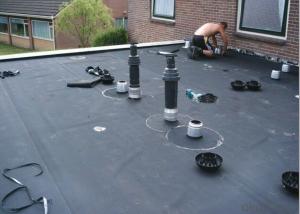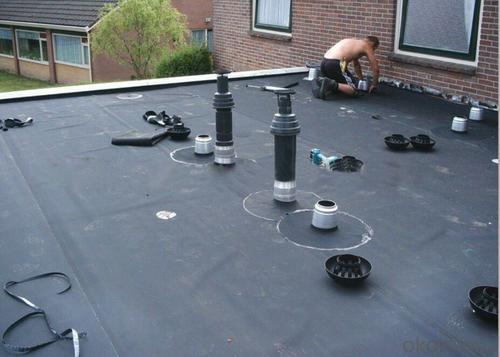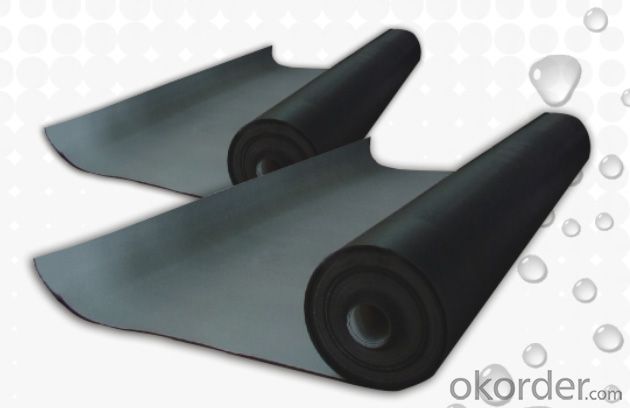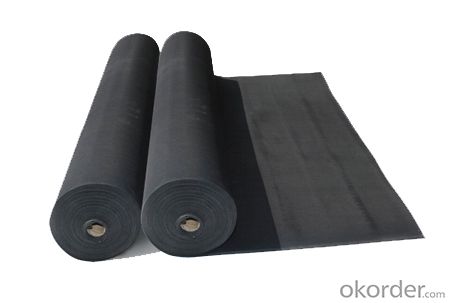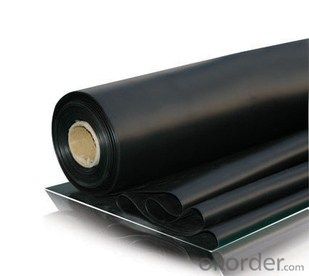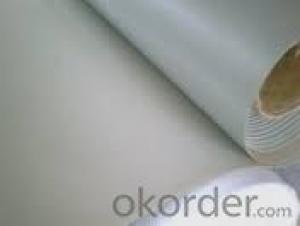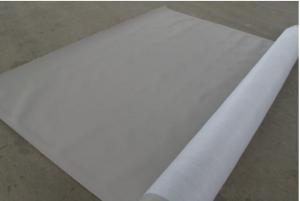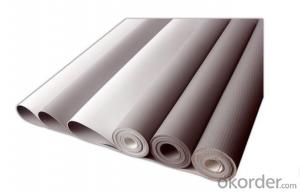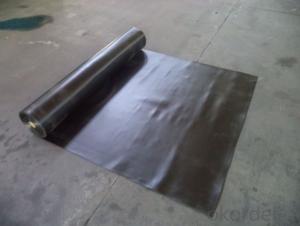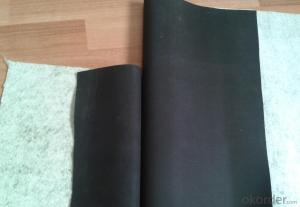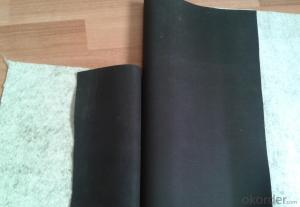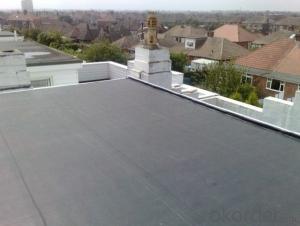EPDM Coiled Rubber Waterproof Membrane with Advanced Technology
- Loading Port:
- Shanghai
- Payment Terms:
- TT OR LC
- Min Order Qty:
- 50000 m²
- Supply Capability:
- 5000000 m²/month
OKorder Service Pledge
OKorder Financial Service
You Might Also Like
EPDM Coiled Rubber Waterproof Membrane with Advanced Technology
Description Of EPDM Coiled Rubber Waterproof Membrane with Advanced Technology:
•EPDM waterproof sheet has excellent anti-ozone-aging performance, able to resist ultraviolet light and corrosion of many chemical corrosive materials in the atmosphere
•It has high tensile strength, high ductility and strong retractility, it has excellent crack resistance, able to effect waterproof function even with tiny vibration of buildings.
• Excellent resistance to ozone, oxidation and sunlight.
• Resistance to chemicals; resistant to most inorganic products.
Main Features of EPDM Coiled Rubber Waterproof Membrane with Advanced Technology:
A.Polyester based SBS Modified Bitumen Waterproofing Membrane
a. Strong impermeability
b. High tensile strength, elongation, ability to adapt the grassroots shrinkage deformation and cracking
c. Puncture-resistant, broken resistant, tear-resistant
d. The corrosion resistance, resistance to mildew, weathering good
e. Construction convenient, hot-melt can be operated Four Seasons Construction, reliable joints
Specifications of EPDM Coiled Rubber Waterproof Membrane with Advanced Technology:
| Material | EPDM Rubber |
| Size | 1.2m (width)*20m (length) or customized, weldable type 2.05m or 4m width |
| Thick | 1.2mm, 1.5mm, 2.0mm |
| Type | Vulcanized & Weldable |
| Pattern | Non-reinforced (homogeneous) |
| Certificate | ISO9001/14001 |
Applications of EPDM Coiled Rubber Waterproof Membrane with Advanced Technology:
1. The substratum should be smooth, dry, clean, which can not have loosing and peeling phenomena.
2. Before application, clean up the basic level and eradicate the impurities.
3. Spread out the membrane on the substratum to loose sheet's stress. Use adhesive-glue to paint the substratum and the surface of membrane. When the adhesive is not sticky to hands, pave and press smoothly.
4. When pave the second volume of membrane, extrude 100mm of the edge of overlap of the first roll and do not paint with the adhesive. Pave the membrane on the substratum according to step so as to finish the whole pavement. When paving, do not tighten the waterproof membrane violently.
5. After that, use the special solvent to scrub the overlap joint. When it becomes fully dry , use the sheet glue to paint the both sides of the joint. Paint it again when it gets completely dry. Till the adhesive is not sticky to hands, press it smoothly and solidly.
6. Pay attention to fire prevention during application. Basement construction site shall be equipped with ventilation facilities
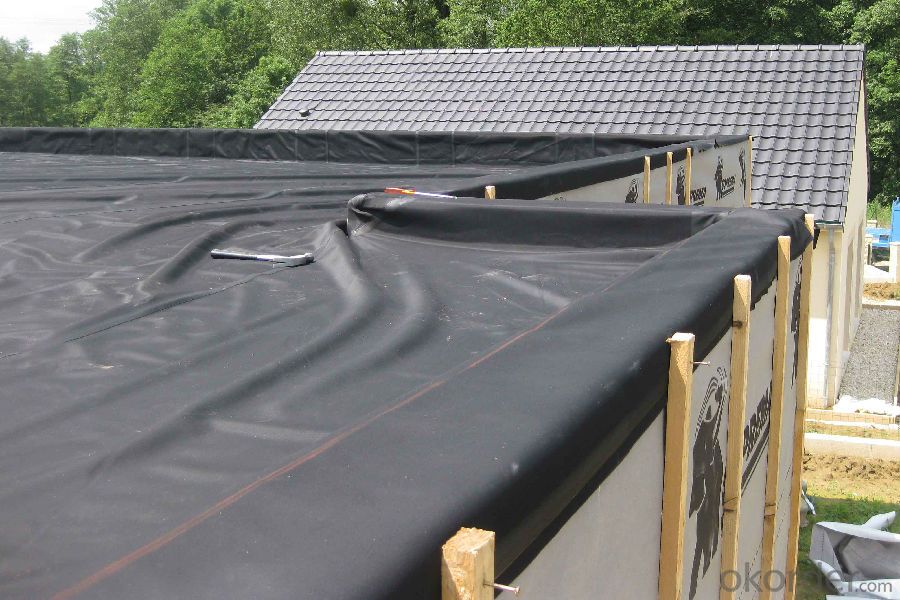


IMages of EPDM Coiled Rubber Waterproof Membrane with Advanced Technology:
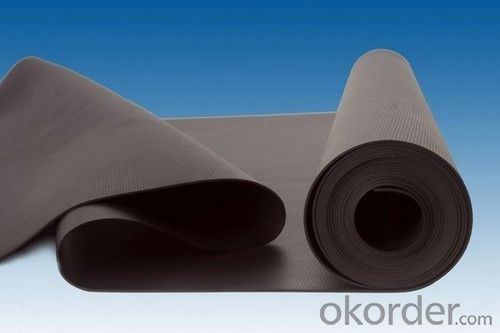



FAQ of EPDM Coiled Rubber Waterproof Membrane with Advanced Technology:
1. What are we supplying?
We are specialized in producing Colorful Asphalt Roof Shingle, SBS/APP modified bitumen waterproof membrane, Self adhesive bitumen waterproof membrane, PVC waterproofing membrane, EPDM rubber roofing membrane, Single Component Polyurethane Waterproof Coating, and Spray Polyurea Waterproof Coating
.
2. How Many years experience do we have?
We have been exported to more than 20 countries in the past 15 years.
3. How long do we usually reply your request?
We always reply our customer within 24 hours.
- Q: Can a waterproofing membrane be used in chemical or hazardous environments?
- Indeed, a waterproofing membrane proves effective in chemical or hazardous surroundings. Its purpose is to serve as a barrier against water, moisture, and other liquids, including chemicals and hazardous substances. Typically, these membranes are constructed from chemical-resistant materials like polyurethane, PVC, or modified bitumen. This composition ensures their durability and ability to withstand exposure to various chemicals without harm. Nevertheless, it is vital to choose a waterproofing membrane specifically designed for chemical or hazardous environments to guarantee compliance with necessary requirements and standards. Moreover, proper installation and maintenance play a crucial role in ensuring the long-lasting effectiveness of the waterproofing membrane in such settings.
- Q: Is the waterproofing membrane an insulating material?
- Insulation board: plastic plate is made of plastic sheet, plastic for the synthesis of polymer compounds, can be free to change the body style. Plastic is the use of monomer raw materials to synthesis or condensation reaction polymerization of materials, synthetic resin and filler, plasticizers, stabilizers, lubricants, colorants and other additives, and its main component is synthetic resin.
- Q: SBS Shale Waterproof Coil
- Classification: According to physical indicators are divided into: Ⅰ (-20 ℃), Ⅱ (-25 ℃) type two categories.
- Q: How does a waterproofing membrane handle freeze-thaw cycles?
- The ability to endure freeze-thaw cycles is a crucial characteristic of a waterproofing membrane. It must possess specific properties that allow it to expand and contract without compromising its integrity. Freeze-thaw cycles occur when water enters the membrane and freezes during colder temperatures, causing it to expand. When the ice melts during warmer temperatures, the membrane should be able to contract back to its original state. In order to handle freeze-thaw cycles, a waterproofing membrane typically possesses elasticity and flexibility. This enables it to adjust to the expansion and contraction without cracking or breaking. It may also have a low water absorption rate to prevent water from seeping into the membrane. Moreover, the membrane should exhibit excellent adhesion to the substrate to ensure it remains in place during temperature fluctuations. Certain waterproofing membranes incorporate special additives or technology to enhance their freeze-thaw resistance. These additives may consist of polymers or elastomers that enhance the membrane's ability to withstand extreme temperature changes. Furthermore, some membranes have reinforced layers or fabric inserts that provide additional strength and durability, making them better equipped to handle freeze-thaw cycles. All in all, a well-designed waterproofing membrane should effectively endure freeze-thaw cycles by possessing elasticity, flexibility, resistance to water absorption, and strong adhesion to the substrate. This guarantees the longevity of the membrane and prevents water infiltration, ultimately protecting structures from potential damage caused by freeze-thaw cycles.
- Q: Can a waterproofing membrane be used on green roofs?
- Yes, a waterproofing membrane can be used on green roofs. It is an essential component of the green roof system as it prevents water from penetrating the roof structure and causing damage. The waterproofing membrane ensures that the roof remains watertight and protects the building below from potential leaks.
- Q: Can a waterproofing membrane be used for a planter box waterproofing?
- Yes, a waterproofing membrane can be used for planter box waterproofing. The membrane helps to prevent water from seeping through the planter box and causing damage to the surrounding structures. It acts as a barrier between the soil and the planter box, ensuring that water stays contained within the box.
- Q: Can a waterproofing membrane be used for bridges and overpasses?
- Yes, a waterproofing membrane can be used for bridges and overpasses. Waterproofing membranes are commonly used in the construction industry to protect structures from water infiltration, including bridges and overpasses. These membranes are designed to create a barrier between the structure and moisture, preventing water from seeping into the concrete or steel components. By installing a waterproofing membrane, the lifespan of a bridge or overpass can be significantly extended, as it helps to prevent corrosion, concrete degradation, and other damages caused by water exposure. Additionally, waterproofing membranes can also provide protection against other environmental factors such as freeze-thaw cycles, chemicals, and UV radiation. Therefore, using a waterproofing membrane for bridges and overpasses is a common practice to enhance their durability and longevity.
- Q: Can a waterproofing membrane be used in roofs?
- Yes, a waterproofing membrane can be used in roofs. Waterproofing membranes are often used in roofing systems to provide a protective barrier against water infiltration, preventing leaks and water damage.
- Q: Are waterproofing membranes resistant to algae growth?
- Yes, waterproofing membranes are generally resistant to algae growth. Waterproofing membranes are designed to be highly durable and resistant to various environmental factors, including the growth of algae. They are typically made of materials such as PVC, TPO, or EPDM that are inherently resistant to algae and other microbial growth. Additionally, waterproofing membranes are often treated with anti-algae and anti-fungal agents during their manufacturing process to further enhance their resistance to algae growth. However, it is important to note that while waterproofing membranes are resistant to algae growth, they may still require regular cleaning and maintenance to ensure their long-term performance and prevent any potential build-up of dirt or debris that could potentially provide a favorable environment for algae to grow.
- Q: Can a waterproofing membrane be used in areas with chemical exposure?
- Yes, a waterproofing membrane can be used in areas with chemical exposure. However, it is essential to choose a membrane specifically designed to withstand the chemicals present in the environment. The membrane should have chemical resistance properties and be compatible with the specific chemicals it will be exposed to in order to provide effective protection against water damage and chemical degradation.
Send your message to us
EPDM Coiled Rubber Waterproof Membrane with Advanced Technology
- Loading Port:
- Shanghai
- Payment Terms:
- TT OR LC
- Min Order Qty:
- 50000 m²
- Supply Capability:
- 5000000 m²/month
OKorder Service Pledge
OKorder Financial Service
Similar products
Hot products
Hot Searches
Related keywords
